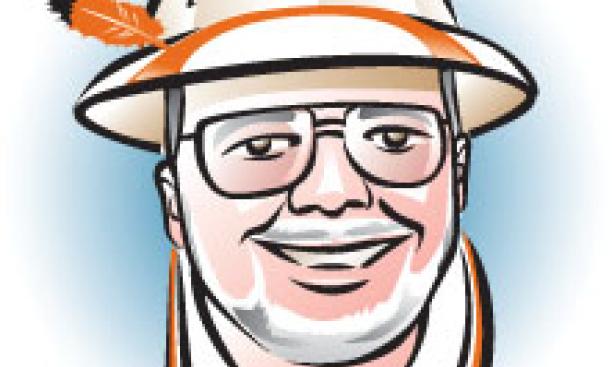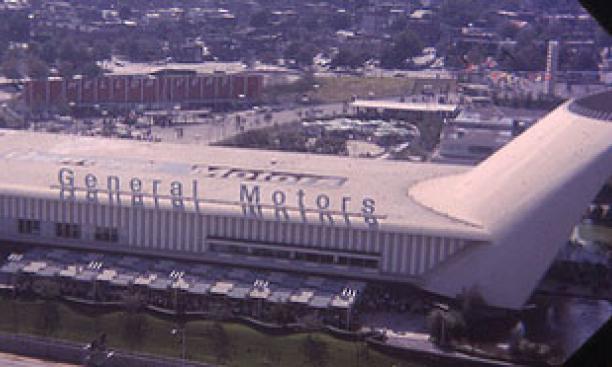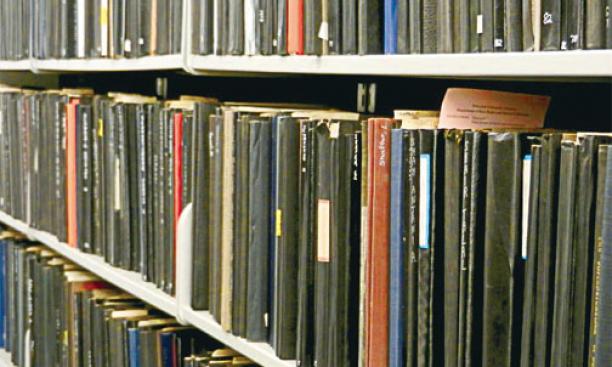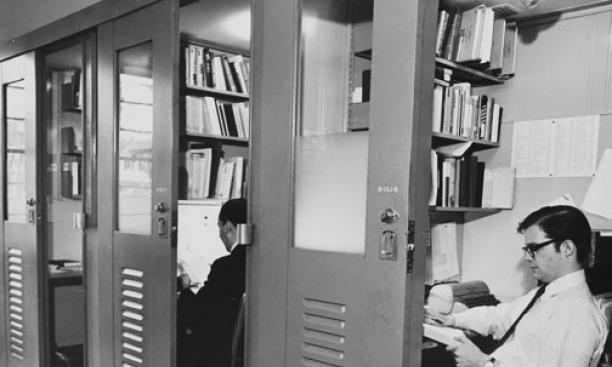
Butterfly in the sky,
I can go twice as high.
Take a look, it’s in a book:
A Reading Rainbow
— Horelick, Kleinman, and Weir

Each time I peruse a press release about a new, earthshattering technology or product – about every 12 seconds these days – I remember Futurama. Not Matt Groening’s wonderful animated series (although Bender is one of my TV faves) but its namesake, the General Motors exhibit at the 1964-65 New York World’s Fair, in convenient contiguity to Casey Stengel and the Amazin’ Mets. The benevolent folks from GM wanted to show us the future in 1984 (ta-ta-DUH) and created detailed working models of fanciful cityscapes – no messy cows here – with, to your amazement, loads of whizzing cars and trucks, none of which ever impeded a pedestrian or got into an accident. I am willing to forgive the ride’s creators their tiny personal heliports at homes and offices (probably a nod to The Jetsons, that era’s own Futurama); however, the electronic expressways, where you hit the on-ramp, then sat back and read a book as you and your passengers zoomed to your destination exit at a fully-automated 80 or 90 mph: That I’m still waiting for. Disillusioned. In New Jersey.

So you can understand that when I read about Coursera, Princeton’s current adventure into the brave new world of MOOC [your own joke here], my jaundiced skepticism tends to surface yet again. I fully understand that competitive forces require the University to explore the potential opened up by the Web and its various acolytes; in fact, my trepidation is not on the supply side at all. The seven Princeton professors currently with nine Coursera offerings are to be congratulated, and I hope they each get a couple hundred thousand participants and a little gold star in whatever strange (online?) ledger is kept by the dean of the faculty these days, if only for letting twits like me critique their efforts. It’s the demand side that concerns me, and while I’m willing to give the 2,644,310 “Courserians” (not my term, I assure you) credit for initiative, I do believe the entire concept reawakens the questions of who we really are as a species, and of what learning truly consists.
And while there are a variety of well-reasoned opinions on the potential of MOOC, I can tell you one thing for sure: If you haven’t gained some sort of wisdom by your Princeton thesis due date, you’re already dead.

The Princeton thesis, a hallmark of our institution that has gone on to enliven Hollywood bio sheets and presidential elections, is actually the evolutionary result of educational insights a century ago. As a rite of passage, it surpasses in universality and personal identity any other aspect of an undergraduate’s career, to include such ephemera as bicker, sports championships, phat hoagies, political causes, or (dare I say it) sex. You just knew when such attendant suggestions recently were floated as ripping the carrels out of Firestone or not accreting any more printed thesis copies in the University Archives, things might get testy. Correct, oh sage.
But let’s begin before the start, with (yet again) Princeton president Woodrow Wilson 1879. Before he could initiate anything as complex as small-section precepts, with their implicit doubling of the faculty, he had to have some sort of academic administrative structure in which to run them; thus, in 1904, the University at the behest of Wilson and the faculty initiated its departments and set up a fixed course of study for freshmen and sophomores, followed by two years of elective courses with an optional honors program. The subsequent casualty rate among those numerous undergrads who were then on campus mainly to attain social standing was high, especially when the 50 “preceptor guys” arrived in the fall of 1905 to demand that actual learning take place.
The usual pattern was five courses per semester, and departments stabilized in rapid order, along with such significant facilities as Guyot Hall, Palmer Lab, and McCosh Hall, which was custom-built for the new pedagogy. That academic structure matured and then, by the Roaring ’20s, plateaued, with a plethora of gentlemen’s Cs flooding the classrooms. The honors program withered out during World War I.
Now, John Grier Hibben 1882, class valedictorian and last of the parson presidents of the University, didn’t like this at all. Esteemed math professor Luther Pfahler Eisenhart was ready with an idea to counteract the malaise, by paradoxically reducing the number of courses for juniors and seniors to four (hence “the four-course plan”). The devil’s bargain: Half of those would be in a major department, and the time freed up would be used for independent study in the home department, with a comprehensive exam required at the end of the senior year to prove competence in the major field. This would be required of every student, i.e., there was nowhere to hide; everybody was in “honors.” The faculty approved it in 1923, and another cluster of academic casualties ensued, with the shrieks heard all the way to “The Faculty Song”:
Luther Pfahler Eisenhart,
Efficient from the very start;
But he’s condemned in the eyes of man
For originating the four-course plan.
Even so, the aggressive departments – English, econ, and bio were the first – that early on demanded a senior-year departmental paper be a precursor to their comps got such a good reaction (after the theses were completed and handed in, of course, not during) that by the early ’30s, theses were required by virtually everyone, and became the uniform rite of passage we know today. But in a technical sense they never have been a requirement of the faculty, as the senior comps are.
In the first 10 years of the plan, per-student use of the library doubled. Even in the ’20s, the Pyne/Chancellor Green library complex was barely adequate to the strain of the new wave of researchers, and by World War II it was seriously impeding undergrad independent work. This was so apparent that baked into the design of the new Firestone Library in 1948 were 500 carrels for thesising, and many alums who barely can remember what department they were in still know their carrel combination by heart. From the day the great open-stack Firestone opened, seniors averaged 50 books per year checked out to the carrels, and by 1957 the University-wide per-student use of the library had doubled yet again. The library’s usage per student was, and remains today, the highest in U.S. undergraduate education.

Beginning last year, the mammoth new Firestone rehab project reached its first carrel, and the mini-bomb dropped: The carrels were through. Gradually being replaced by open sitting cubbies with even more space, which will be booked ad hoc (supported by individual book lockers), they are partly a reaction to the drop (in the Wi-Fi age) of on-site usage to about 3 percent per day. The provost and librarian mounted an admirable campaign to elicit recommendations and head off objections among the seniors, but it still would be a good idea to keep some smelling salts around on B Floor for the apoplectic alums on their infrequent pilgrimage to their old carrels, now MIA. I’ve started to hear from them already.
When it opened in 1977, the new Mudd Library gathered the University Archives, notably including a bound copy (I’m sure we’ll hear from veterans of the Thesis-Binding Agency, too) of every senior thesis from 1926 forward . Now numbering 60,000 or so, they go from Oscar-winner Jose Ferrer ’33 (“French Naturalism and Lardo Bazan”) to Sen. Ted Cruz ’92 (“Clipping the Wings of Angels: The History and Theory behind the Ninth and Tenth Amendments of the United States Constitution”) and beyond, clear up to the Class of 2012. There, they will stop. In October, the Muddies announced that PDFs are the new coin of the thesis realm, and of course the Class of ’13 has not taken kindly to being the first digitized. Among the more printable reactions: “Why not digitally archive the old ones to make room for the new?” (likely from someone who’d read mine), “This suckssssss,” and a plaintive note from a prospective 200-page author: “Nooooooooooooooooooooooooooooooooo!!!”
I certainly can sympathize with these good folks, being used as guinea pigs in the brave new environment of musical carrels and virtual theses. In the accelerating new century, this sort of dislocation happens to all of us sooner or later, so I guess sooner may be better in terms of effective education. And besides, they already have lots of good company, including me and Lardo Bazan, waiting patiently with them here in the on-ramp at Futurama.
